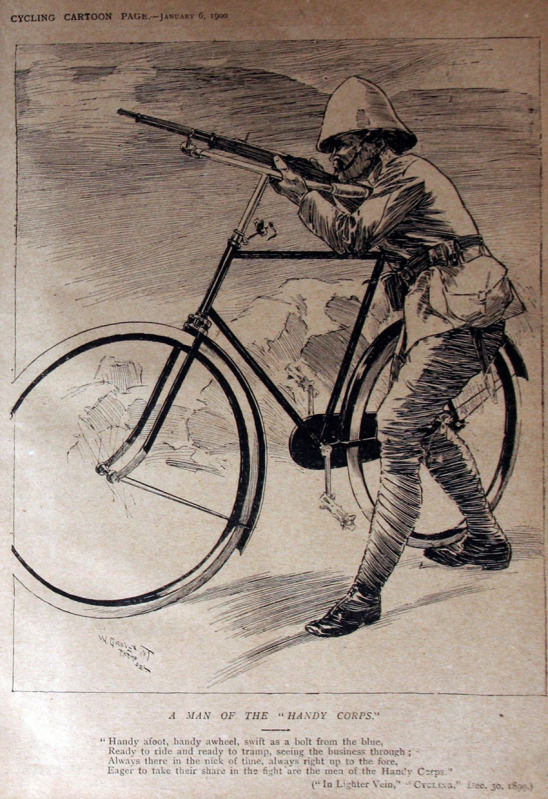New Military Bicycle Forum
I’m now available at the following forum:
http://thecabe.com/vbulletin/forumdisplay.php?43-Military-Bicycles
A MAN OF THE HANDY CORPS
Handy afoot, handy awheel, swift as a bolt from the blue,
Ready to ride and ready to tramp, seeing the business through;
Always there in the nick of time, always right up to the fore,
Eager to take their share in the fight are the men of the Handy Corps
– In Lighter Vein, Cycling Magazine, 30th Dec 1899
Similar issues were reported in the US military.
By WW1, the development of motor vehicles had evolved sufficiently that bicycles were generally relegated to subsidiary tasks (though they still proved useful for silent reconnaissance duties).
The Boer War (1899-1902) occurred before before motorized vehicles came into general use, so was the first and only campaign where bicycles were employed by both sides and undoubtedly proved their worth.
British bicycle troops in South Africa during the Anglo-Boer War numbered several hundred. There was much resentment against their use by the cavalry and, officially, they were mostly used for carrying despatches. But the cyclists always ready for other tasks; they were particularly effective for scouting and spying missions.
An account of a cyclist published in the Bath Cycling Club Gazette tells of a narrow escape. N.C. Harbutt was given a despatch to take the next post 27 miles (43 km) away. The officer told him to ‘… take the machine – it’s quieter than a horse’ and also told him that he was to travel light, taking a Mauser pistol rather than a rifle. He got onto his khaki-coloured Raleigh and was off. Travelling without a light, he had several spills before he approached a drift in the Renoster Spruit which he avoided by going downstream and then crossing, getting thoroughly wet in the process. Hardly thirty yards had been covered when several shots from a Mauser rifle were fired in his direction. He answered with his pistol and rode off at top speed. When camp was reached he discovered that he had covered several miles with a flat front tyre. The next morning a patrol discovered the footprints of at least three Boers in a spot covering the drift where he would normally have crossed.
The only official cyclists on the Boer side were the 108 members of the Wielrijders Rapportgangers Corps. Cyclists were used a lot by the Boers, and with particular success in various battles.
Extraordinary tasks were sometimes given to cyclists, one of which was to transport carrier pigeons, as it was found that carrying them on horseback upset them, whereas they took more kindly to cycle transportation. Scout Callister of the Cape Cycle Corps achieved great fame by ‘cycling 120 miles, gaining a vantage point, lying perdu (hidden) for several days, and then releasing birds whenever he saw Boer activity.’ Maj B.F.S. Baden-Powell of the 1st Battalion Scots Guards even had a collapsible bicycle which carried a kite. The kite was used at first for taking photographs of the camp by a remotely controlled camera, and later for raising an aerial for experiments in wireless telegraphy between Modder River Station and Belmont.
A special ‘War Cycle’ was built for use on railway lines (above). It was introduced into South Africa by the Royal Australian Cycle Corps and had a detachable rim which was fitted to the pneumatic tyres, enabling it to be used on rails. When the rim was removed the bicycle could be used on normal roads. These cycles were used for reconnaissance, for carrying despatches, checking the railway line for demolition charges, and also for removing the wounded from a skirmish taking pace near a railway.








